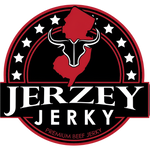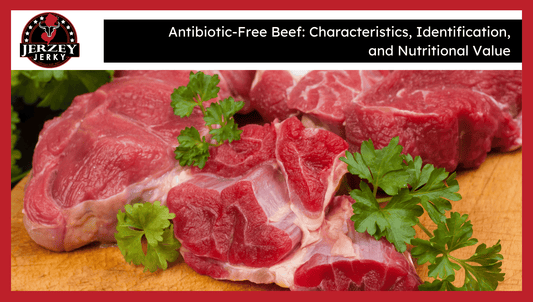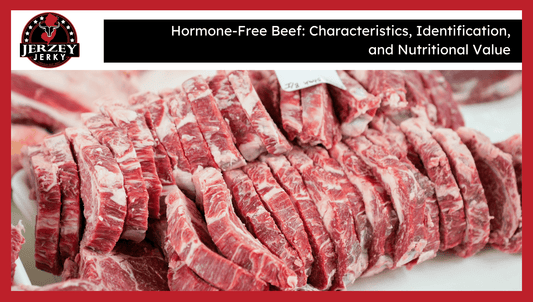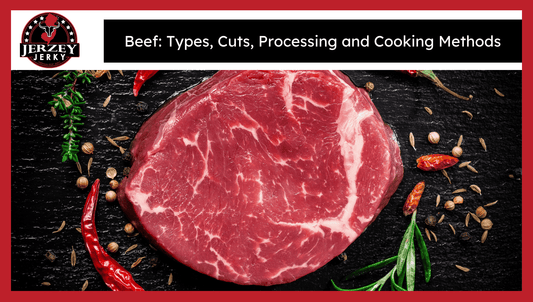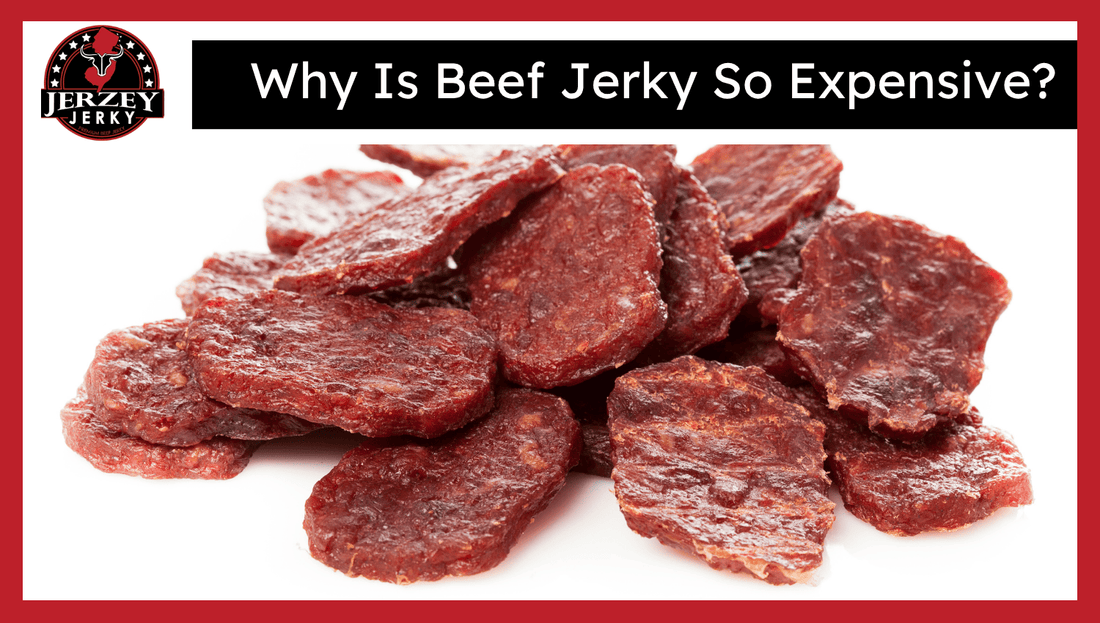
Why Is Beef Jerky So Expensive?
Beef jerky is a costly delicacy since it takes a very large portion of raw meat to result in a small portion of a completed product. Raw beef has to be dehydrated into just 1 pound of jerky using 3 pounds of beef.
The dehydration process decreases the initial weight of the meat by up to 65 percent. This process focuses on flavor and nutrition yet ends up with a great deal less marketable product, so per-ounce costs go up.
Working increases the cost. Trimming, slicing, marinating and checking the batches take hours. Manual handling increases the cost of labor drastically.
Statistics reported by the USDA show that the prices of beef rose by 19.2 percent between the period of 2020 and 2022. Raw beef became more expensive to jerky makers due to drought, increased feed prices and fuel expenses.

Why Is Raw Beef So Expensive for Making Jerky?
Here are two main points explaining the cost of raw beef:
- Lean Cuts Required: Jerky needs premium lean cuts such as top round, sirloin, or flank steak. These cuts have less fat and higher protein, making them more costly. Retail prices range from $6.90 to $9.70 per pound, increasing the raw beef cost for jerky.
- Shrinkage During Drying: Dehydration removes regarding 50–65% of raw beef’s weight by eliminating moisture and fat. It takes between 2.5 and 3 pounds of. And raw beef to make 1 pound of jerky. This weight loss raises the amount of raw meat necessary.
How Does the Preparation Process Add to Jerky’s Cost?
Here are the three key factors that raise jerky’s preparation cost:
- Manual Trimming and Slicing: Experienced workers trim fat and evenly cut meat according to a batch. This labor is experience-based and requires accuracy. Fat removal enhances the jerky quality but escalates labor time and expenses thus causing the process to be slower and more costly as compared to automated processes.
- Long Marination Time: Jerky basks in marinade between 6 and 24 hours. Such extended marination decreases productivity because the machine and time are spent a greater amount of time in operation. The longer the soaking period, the better the flavor takes but the higher the processing expenses since it reduces the amount of jerky that producers produce per day.
- Batch-by-Batch Handling: The batches are trimmed, marinated, and dried separately. Small lot loading of jerky is slower and uses more labor time. The large-scale production is restricted by this method making the cost per pound higher than when continuously or automatically producing jerky.
Why Does the Drying and Cooking Time Make Jerky Pricier?
Here are the three reasons drying and cooking add to the cost:
- Low and Slow Dehydration: There is slow drying of jerky in 4 to 8 hours on low heat. This puts a great burden on energy and prolongs machine operations. The time-consuming method maintains the flavor and texture but increases the expense of electricity and equipment in the manufacturing.
- Safety Batch Control: Manufacturers are keen on temperature and bacteria per batch. This clears the food of infection but it takes additional labour and time. Ensuring tight control is a slow way of production, needs a higher labour force, and costs more in general when it comes to producing jerkies that are safe and well-made.
- Regular Texture Objectives: Jerky manufacturers aim for ideal chewiness through test batches. They also regulate drying time and heat to prevent dry jerky or chewy jerky. These types of checks require additional time and effort to raise the cost of labor and production to satisfy texture quality.
How Do Seasonings and Marinade Ingredients Affect the Cost?
Here are three key ways seasonings and marinades raise jerky costs:
- Use of Quality Marinades: Jerky marinades are soy sauce, Worcestershire sauce, spices, and natural flavorings. These ingredients are more expensive than their artificial counterparts; however, their flavor and odor are better. Ingredient costs increase when the manufacturer uses quality ingredients, which increases customer appeal and the overall flavor of the jerky.
- No fillers or binders: Jerky products consist of genuine meat and additives that have no fillers or binders typically found in the processed meat sector. Avoiding cheap additives makes the raw material more expensive yet maintains the natural texture, taste and quality. Such a clean-label strategy increases the costs of production.
- Small Batch Blend: Producers also mix marinades in small quantities to achieve an individual taste and crispness. Mixing in small batches places constraints on the bulk ingredient discount and is more time-consuming. This is a handcrafted process that increases its cost relative to the mass-produced marinade in bulk quantities.
How Does Packaging and Preservation Increase the Cost of Jerky?
Here are factors in packaging that raise jerky costs:
- Vacuum Sealing or Nitrogen Flushing: Preservatives such as vacuum sealing or nitrogen flushing prevent air to lengthen the shelf life. Such methods require special machines and precautions. The procedure adds a material and operational cost per pack and it does not use cold storage systems.
- Food-Grade Materials: Jerky packaging is done using foil and layers of plastic which do not permit air, moisture and light. Such materials comply with high safety requirements and are not fragile. They cost more to produce due to their food safety and durability certifications than their usual consumer packaging.
- Resealable Features: Contemporary jerky packaging comes with zippers, sliders, and tear notches to reuse. The features enhance freshness and convenience and necessitate the use of additional parts and tooling. The packaging lines require custom reseal designs which add to the cost of the material and the amount of time to set up the machine.
What Role Do Compliance and Safety Standards Play in Pricing?
Here are the safety and legal reasons that increase the jerky cost:
- Regulatory Requirements: The FDA and USDA apply strict standards to dried meats. Facilities are considered in hygiene procedures, thorough monitoring, and staff education systems. These are government-prescribed steps that amplify its administration burden, necessitate additional employee time, and incur indirect costs within jerky production and document management structures.
- Agents and Additives: Jerky recipes contain approved curing agents to lower the risk of harmful bacteria. Additives such as sodium nitrite do not exceed allowable safety levels. These compounds require careful formulation and mixing and this makes production more complex and expensive than uncured or fresh meat.
- Testing and Certification: All batches of Jerkies go through laboratory testing for pathogens and product labeling. Licensed laboratories involve a fee per test, and failed tests need to be discarded or retested. Accommodating such certification requirements requires tight control of the process, which adds quality assurance costs and costs more time to market.
Why Does Shelf-Stable Convenience Make Jerky More Expensive?
Here are the three key convenience factors that increase Jerky’s cost:
- Ready-to-Eat Format: Jerky is ready-to-go food that does not require any utensils, heating, or cleanup. Such convenience is a source of genuine value. It is dried differently from raw meat, but it is also treated with additional procedures after drying to remain safe and consumable in its packaging.
- Compact and Lightweight: It is lightweight and fits outdoor people, athletes and travelers. Jerky is a high-protein food that is compact unlike canned or bulky food. This particular utility leads to steady demand, which allows sellers to sell it at higher rates in the travel and gear categories.
- Long Lasting Shelf Life: Jerky remains are usually good to last 6-12 months. This longevity is achieved through exacting control of moisture and microbial stability as well as compliance. The avoidance of preservatives and a long shelf life necessitate special formulation and environmental protection, which contribute to the higher cost of the end product.
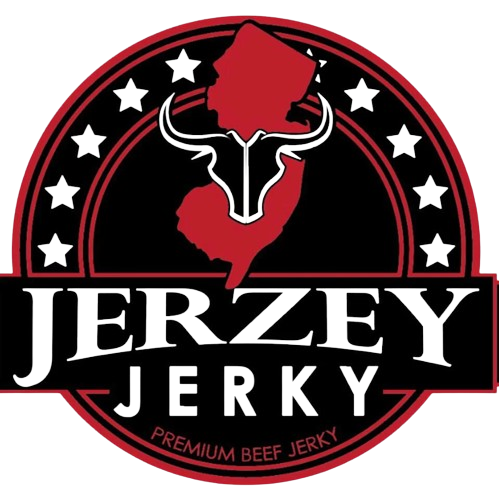
 2025-07-23
2025-07-23
 Wayne Holland
Wayne Holland
